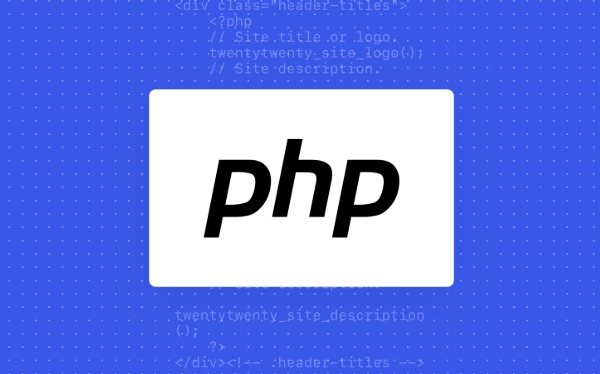To run the first PHP script, you must first build a server environment, and then write basic code to test and run. 1. Locally install integrated environments such as XAMPP, WAMP or MAMP; 2. Use PHP that comes with Mac or Linux system; 3. Run code through an online PHP editor; 4. Place the PHP file in the server directory such as htdocs; 5. Write a .php file containing <?php echo "Hello, world!"; ?>; 6. Visit http://localhost/test/index.php through the browser to view the results; 7. Pay attention to check whether the server is running, whether the path is correct and whether the syntax is wrong; 8. You can try to output time or process forms and deepen your understanding.

It is actually not difficult to run your first PHP script. As long as the environment is well set and the writing method is correct, you can quickly see the effect. PHP is a server-side language, so you cannot open it directly in the browser like HTML or JavaScript. You need a server environment that supports PHP.

Ready to run the environment
To run PHP scripts, you must first make sure you have an environment that can execute PHP. Common methods are:
- Local installation of XAMPP, WAMP or MAMP : These toolkits integrate Apache, MySQL and PHP, making them suitable for beginners to quickly build environments.
- Use the PHP (Mac or Linux) that comes with the system : Some systems have PHP pre-installed. You can enter
php -vthrough the terminal to see if it is installed. - Online PHP editor : such as 3v4l.org or onlinephp.io, such websites can run PHP code directly without configuring the local environment.
After the installation is completed, it is recommended to place the PHP file in the server directory, such as the htdocs folder of XAMPP, so that it will be correctly parsed when accessed through the browser.

Write a simple PHP file
Create a new file with .php suffix, such as index.php , and then write the most basic code in it:
<?php echo "Hello, world!"; ?>
A few points to note:

- The start tag
<?phpand end tags?>cannot be omitted (although the end tag can be omitted in pure PHP files, it is recommended for beginners to keep it). -
echois the keyword of the output content, followed by a string or variable. - Each statement ends with a semicolon.
After saving, put this file in the server directory, such as http: htdocs/test/index.php , and then visit http://localhost/test/index.php in the browser to see the output Hello, world!.
FAQs and debugging tips
Sometimes, you clearly wrote the correct code but you can't see the expected results. This may be due to the following reasons:
- Not accessed through the server : it is not possible to open the
.phpfile directly by double-clicking, it must be accessed through a method similar tohttp://localhost/xxx. - The server is not started : If you are using XAMPP or WAMP, you must start the Apache service first.
- There is a syntax error in the code : you can add
ini_set('display_errors', 1);to the top of the PHP file to make the server display the error message. - File encoding or path problems : Try to name files and paths in English to avoid parsing failures in Chinese or special characters.
If the page is blank and does not output, check the above points first, basically all the problems can be located.
Try adding some small functions
After you can run the first script smoothly, you can try adding a little function, such as outputting the current time:
<?php
echo "The current time is: " . date("Ymd H:i:s");
?>Or make a simple form processing:
<?php
if ($_SERVER["REQUEST_METHOD"] == "POST") {
$name = $_POST["name"];
echo "Hello," . htmlspecialchars($name);
}
?>
<form method="post">
<input type="text" name="name">
<input type="submit" value="submit">
</form>These small examples can help you understand PHP's running mechanism faster.
Basically that's all, running the first PHP script doesn't require too many steps, but some details are easy to ignore. As long as the environment is good, writing a simple script will run quite quickly.
The above is the detailed content of Running Your First PHP Script. For more information, please follow other related articles on the PHP Chinese website!

Hot AI Tools

Undress AI Tool
Undress images for free

Undresser.AI Undress
AI-powered app for creating realistic nude photos

AI Clothes Remover
Online AI tool for removing clothes from photos.

Clothoff.io
AI clothes remover

Video Face Swap
Swap faces in any video effortlessly with our completely free AI face swap tool!

Hot Article

Hot Tools

Notepad++7.3.1
Easy-to-use and free code editor

SublimeText3 Chinese version
Chinese version, very easy to use

Zend Studio 13.0.1
Powerful PHP integrated development environment

Dreamweaver CS6
Visual web development tools

SublimeText3 Mac version
God-level code editing software (SublimeText3)
 Object-Relational Mapping (ORM) Performance Tuning in PHP
Jul 29, 2025 am 05:00 AM
Object-Relational Mapping (ORM) Performance Tuning in PHP
Jul 29, 2025 am 05:00 AM
Avoid N 1 query problems, reduce the number of database queries by loading associated data in advance; 2. Select only the required fields to avoid loading complete entities to save memory and bandwidth; 3. Use cache strategies reasonably, such as Doctrine's secondary cache or Redis cache high-frequency query results; 4. Optimize the entity life cycle and call clear() regularly to free up memory to prevent memory overflow; 5. Ensure that the database index exists and analyze the generated SQL statements to avoid inefficient queries; 6. Disable automatic change tracking in scenarios where changes are not required, and use arrays or lightweight modes to improve performance. Correct use of ORM requires combining SQL monitoring, caching, batch processing and appropriate optimization to ensure application performance while maintaining development efficiency.
 Building Immutable Objects in PHP with Readonly Properties
Jul 30, 2025 am 05:40 AM
Building Immutable Objects in PHP with Readonly Properties
Jul 30, 2025 am 05:40 AM
ReadonlypropertiesinPHP8.2canonlybeassignedonceintheconstructororatdeclarationandcannotbemodifiedafterward,enforcingimmutabilityatthelanguagelevel.2.Toachievedeepimmutability,wrapmutabletypeslikearraysinArrayObjectorusecustomimmutablecollectionssucha
 VSCode settings.json location
Aug 01, 2025 am 06:12 AM
VSCode settings.json location
Aug 01, 2025 am 06:12 AM
The settings.json file is located in the user-level or workspace-level path and is used to customize VSCode settings. 1. User-level path: Windows is C:\Users\\AppData\Roaming\Code\User\settings.json, macOS is /Users//Library/ApplicationSupport/Code/User/settings.json, Linux is /home//.config/Code/User/settings.json; 2. Workspace-level path: .vscode/settings in the project root directory
 css dark mode toggle example
Jul 30, 2025 am 05:28 AM
css dark mode toggle example
Jul 30, 2025 am 05:28 AM
First, use JavaScript to obtain the user system preferences and locally stored theme settings, and initialize the page theme; 1. The HTML structure contains a button to trigger topic switching; 2. CSS uses: root to define bright theme variables, .dark-mode class defines dark theme variables, and applies these variables through var(); 3. JavaScript detects prefers-color-scheme and reads localStorage to determine the initial theme; 4. Switch the dark-mode class on the html element when clicking the button, and saves the current state to localStorage; 5. All color changes are accompanied by 0.3 seconds transition animation to enhance the user
 python parse date string example
Jul 30, 2025 am 03:32 AM
python parse date string example
Jul 30, 2025 am 03:32 AM
Use datetime.strptime() to convert date strings into datetime object. 1. Basic usage: parse "2023-10-05" as datetime object through "%Y-%m-%d"; 2. Supports multiple formats such as "%m/%d/%Y" to parse American dates, "%d/%m/%Y" to parse British dates, "%b%d,%Y%I:%M%p" to parse time with AM/PM; 3. Use dateutil.parser.parse() to automatically infer unknown formats; 4. Use .d
 go by example generics
Jul 29, 2025 am 04:10 AM
go by example generics
Jul 29, 2025 am 04:10 AM
Go generics are supported since 1.18 and are used to write generic code for type-safe. 1. The generic function PrintSlice[Tany](s[]T) can print slices of any type, such as []int or []string. 2. Through type constraint Number limits T to numeric types such as int and float, Sum[TNumber](slice[]T)T safe summation is realized. 3. The generic structure typeBox[Tany]struct{ValueT} can encapsulate any type value and be used with the NewBox[Tany](vT)*Box[T] constructor. 4. Add Set(vT) and Get()T methods to Box[T] without
 css dropdown menu example
Jul 30, 2025 am 05:36 AM
css dropdown menu example
Jul 30, 2025 am 05:36 AM
Yes, a common CSS drop-down menu can be implemented through pure HTML and CSS without JavaScript. 1. Use nested ul and li to build a menu structure; 2. Use the:hover pseudo-class to control the display and hiding of pull-down content; 3. Set position:relative for parent li, and the submenu is positioned using position:absolute; 4. The submenu defaults to display:none, which becomes display:block when hovered; 5. Multi-level pull-down can be achieved through nesting, combined with transition, and add fade-in animations, and adapted to mobile terminals with media queries. The entire solution is simple and does not require JavaScript support, which is suitable for large
 python property decorator example
Jul 30, 2025 am 02:17 AM
python property decorator example
Jul 30, 2025 am 02:17 AM
@property decorator is used to convert methods into properties to implement the reading, setting and deletion control of properties. 1. Basic usage: define read-only attributes through @property, such as area calculated based on radius and accessed directly; 2. Advanced usage: use @name.setter and @name.deleter to implement attribute assignment verification and deletion operations; 3. Practical application: perform data verification in setters, such as BankAccount to ensure that the balance is not negative; 4. Naming specification: internal variables are prefixed, property method names are consistent with attributes, and unified access control is used to improve code security and maintainability.






